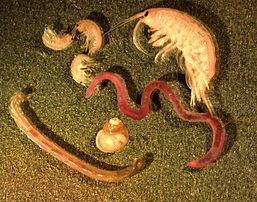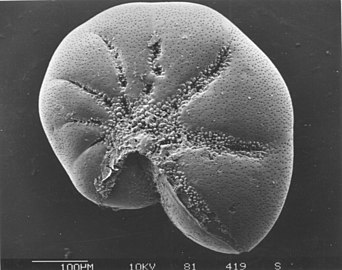Benthos
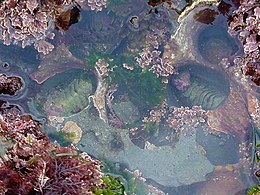
| Part of a series related to |
| Benthic life |
|---|
 |
| Benthos |
Benthos (from
.Many organisms adapted to deep-water pressure cannot survive in the upper parts of the
Because light is
The term benthos, coined by
Overview
Compared to the relatively featureless
By size
Macrobenthos
Macrobenthos, prefix from
-
Sea squirts
-
Aquaticamphipods
Meiobenthos
-
Foraminiferan
-
Tardigrade (water bear)
Microbenthos
Microbenthos, prefix from the Greek mikrós 'small', comprises microscopic benthic organisms that are less than about 0.1 mm in size. Some examples are
.
-
Diatoms
Marine microbenthos are microorganisms that live in the benthic zone of the ocean – that live near or on the seafloor, or within or on surface seafloor sediments. The word benthos comes from Greek, meaning "depth of the sea". Microbenthos are found everywhere on or about the seafloor of continental shelves, as well as in deeper waters, with greater diversity in or on seafloor sediments. In shallow waters, seagrass meadows, coral reefs and kelp forests provide particularly rich habitats. In photic zones benthic diatoms dominate as photosynthetic organisms. In intertidal zones changing tides strongly control opportunities for microbenthos.
-
Elphidium a widespread abundant genus of benthic forams
-
Heterohelix, an extinct genus of benthic forams
- Marine microanimals
-
Darkfield photo of a gastrotrich, 0.06-3.0 mm long, a worm-like animal living between sediment particles
-
Armoured Pliciloricus enigmaticus, about 0.2 mm long, live in spaces between marine gravel
Both foraminifera and diatoms have
The sudden extinction event which killed the dinosaurs 66 million years ago also rendered extinct three-quarters of all other animal and plant species. However, deep-sea benthic forams flourished in the aftermath. In 2020 it was reported that researchers have examined the chemical composition of thousands of samples of these benthic forams and used their findings to build the most detailed climate record of Earth ever.[10][11]
Some endoliths have extremely long lives. In 2013 researchers reported evidence of endoliths in the ocean floor, perhaps millions of years old, with a generation time of 10,000 years.[12] These are slowly metabolizing and not in a dormant state. Some Actinomycetota found in Siberia are estimated to be half a million years old.[13][14][15]
By type
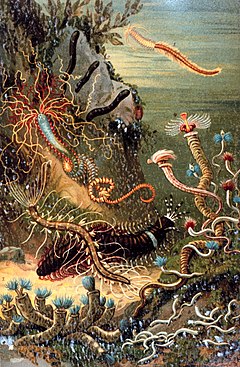
A variety of marine worms
Plate from Das Meer
by M. J. Schleiden (1804–1881)
Zoobenthos
Zoobenthos, prefix from
Phytobenthos
By location
Endobenthos
Endobenthos (or endobenthic), prefix from
Epibenthos
Epibenthos (or epibenthic), prefix from
Hyperbenthos
Hyperbenthos (or hyperbenthic), prefix from
Food sources

on marine benthic life
The main food sources for the benthos are
are important predators and scavengers.Benthic organisms, such as
Ecological role
Benthos as bioindicators
Benthic macro-invertebrates play a critical role in aquatic ecosystems. These organisms can be used to indicate the presence, concentration, and effect of water pollutants in the aquatic environment. Some water contaminants—such as nutrients, chemicals from surface runoff, and metals[16]—settle in the sediment of river beds, where many benthos reside. Benthos are highly sensitive to contamination, so their close proximity to high pollutant concentrations make these organisms ideal for studying water contamination.[17]
Benthos can be used as bioindicators of water pollution through ecological population assessments or through analyzing biomarkers. In ecological population assessments, a relative value of water pollution can be detected. Observing the number and diversity of macro-invertebrates in a waterbody can indicate the pollution level. In highly contaminated waters, a reduced number of organisms and only pollution-tolerant species will be found.[18] In biomarker assessments, quantitative data can be collected on the amount of and direct effect of specific pollutants in a waterbody. The biochemical response of macro-invertebrates' internal tissues can be studied extensively in the laboratory. The concentration of a chemical can cause many changes, including changing feeding behaviors,[19] inflammation, and genetic damage,[20] effects that can be detected outside of the stream environment. Biomarker analysis is important for mitigating the negative impacts of water pollution because it can detect water pollution before it has a noticeable ecological effect on benthos populations.[21]
Carbon processing
- Carbon processing in marine sediments
Organic matter produced in the sunlit layer of the ocean and delivered to the sediments is either consumed by organisms or buried. The organic matter consumed by organisms is used to synthesize biomass or is metabolized to carbon dioxide and nutrients. In the long-term or at steady-state, i.e., the biomass of benthic organisms does not change, the benthic community can be considered a black box diverting organic matter into either metabolites or the geosphere (burial).[22]
See also
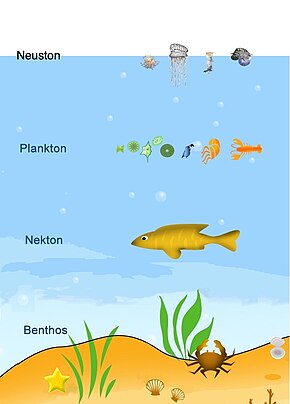
- Aphotic zone
- Benthic fish
- Benthopelagic fish
- Bioirrigation
- Bottom feeder
- Deep sea
- Deep sea communities
- Deep sea mining
- Demersal fish
- Intertidal ecology
- Littoral
- Neritic zone
- Nekton
- Plankton
- Pelagic zone
- Photic zone
- Profundal zone
- Sediment Profile Imagery (SPI)
- Stream bed
Notes
- ^ a b Benthos from the Census of Antarctic Marine Life website
- ^ US Department of Commerce, National Oceanic and Atmospheric Administration. "How does pressure change with ocean depth?". oceanservice.NOAA.gov.
- ^ Haeckel, E. 1891. Plankton-Studien. Jenaische Zeitschrift für Naturwissenschaft 25 / (Neue Folge) 18: 232-336. BHL.
- Perseus Project.
- ^ "North American Benthological Society website". Archived from the original on 2008-07-05. Retrieved 2008-08-16.
- ^ Nehring, S. & Albrecht, U. (1997). Benthos und das redundant Benton: Neologismen in der deutschsprachigen Limnologie. Lauterbornia 31: 17-30, [1].
- ISBN 9780750633840.
- OCLC 46724477.
- SERC, Carleton College. Modified 23 July 2020. Retrieved 10 September 2020.
- ^ Earth barreling toward 'Hothouse' state not seen in 50 million years, epic new climate record shows LiveScience, 10 September 2020.
- S2CID 221593388.
- ^ Bob Yirka 29 Aug 2013
- ^ Sussman: Oldest Plants, The Guardian, 2 May 2010
- ^ "It's Okay to be Smart • the oldest living thing in the world: These". Archived from the original on 2018-07-13. Retrieved 2018-07-13.
- PMID 17728401.
- ^ "Major Contaminants | Contaminated Sediments | US EPA". archive.epa.gov. Retrieved 2022-10-12.
- S2CID 186207664.
- ^ US EPA, OW (2013-11-21). "Indicators: Benthic Macroinvertebrates". www.epa.gov. Retrieved 2022-10-14.
- ISSN 0043-1354.
- .
- PMID 21571352.
- ISSN 1726-4189..
 Material was copied from this source, which is available under a Creative Commons Attribution 4.0 International License
Material was copied from this source, which is available under a Creative Commons Attribution 4.0 International License
References
- "Benthos". (2008) Encyclopædia Britannica. (Retrieved May 15, 2008, from Encyclopædia Britannica Online.)
- Ryan, Paddy (2007) "Benthic communities" Te Ara - the Encyclopædia of New Zealand, updated 21 September 2007.
- Yip, Maricela and Madl, Pierre (1999) "Benthos" Archived 2019-07-20 at the Wayback Machine University of Salzburg.




